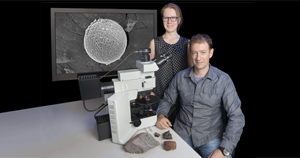- Details
Images (L-R): Portrait of a Woman by Edgar Degas (c). 1876–80 (left); a conventional X-ray of the painting; false colour reconstruction of Degas’ hidden portrait, created from the X-ray fluorescence microscopy elemental maps produced at the Australian Synchrotron.
An alliance of Australian scientists and conservators have made a quantum leap forward in the analysis of priceless artworks, revealing an earlier painting of a different woman beneath a French Impressionist masterpiece in unprecedented detail, using a technology combination unavailable anywhere else in the world.
Shedding light on a decades-old riddle through a unique technology pipeline, researchers from Australian Synchrotron, National Gallery of Victoria (NGV) and CSIRO published stunning images of what lies beneath Edgar Degas’ Portrait of a Woman (c. 1876-1880) in the journal Scientific Reports overnight, midway through the artwork’s display at NGV International as part of Melbourne Winter Masterpieces exhibition, Degas: A new vision.
Dr Daryl Howard, Scientist on the X-ray Fluorescence Microscopy (XFM) beamline at the Australian Synchrotron – the newest addition to the Australian Nuclear Science and Technology Organisation (ANSTO)’s world-class line-up of landmark research infrastructure – says the re-creation of the underpainting was achieved by first producing complex metal maps to highlight minerals in the many paint types.
‘Paint from Degas’ period was primarily composed of ground-up rocks and early synthetic pigments – with copper creating green and mercury creating red, for example – and he swirled and mixed different paints from different tubes on his palette at different times, as did the restorers who touched up this painting into the early twentieth century.
‘Placing the artwork in the path of the Australian Synchrotron beam, which is a million times brighter than the sun, we measured the exact location of different pigment mixtures in every one millimetre square pixel, and fed the vast volumes of data into a computer to reconstruct both the surface and underlying layers.’
Dr Howard says the technique is an ‘order of magnitude’ improvement for non-intrusive art analysis, crucial when handling priceless artworks.
‘Eight years ago, a low resolution three-element image, which revealed a face beneath Vincent Van Gogh’s Patch of Grass 1887, inspired us to refine and advance non-destructive imaging using some of the world’s most advanced scientific technology.
‘This analysis takes this “hands-off” approach to the next level, producing enormous 31.6 megapixel images – beyond the resolution of most of today’s best digital cameras – while subjecting each part of the artwork to radiation for only a fraction of a second to ensure it is not damaged.’
CSIRO engineer Robin Kirkham says the powerful light of the Australian Synchrotron combined with a highly sensitive detector devised at CSIRO are behind the revolutionary new technique.
‘Developed by CSIRO with US project partner Brookhaven National Laboratory over the past few years, the Maia detector can complete complex elemental imaging a hundred times faster than conventional systems.
‘Coupled with the brilliant synchrotron beam, in 33 hours the detector produced images with around 250 times more pixel definition than the far smaller 2008 Van Gogh images that took about two days to produce.’
It’s not the first time the NGV, Australian Synchrotron and CSIRO have joined forces to solve an art mystery. In 2010 similar techniques were used to find a hidden Arthur Streeton self-portrait buried under layers of lead paint and, in 2015, a major project helped uncover hidden secrets in Frederick McCubbin’s The North wind.
Degas: a new vision is exhibiting at NGV until Sunday 18 September.
Media coverage
- ‘Hidden painting beneath Degas' 'Portrait of a Woman' revealed by Australian Synchrotron’, Sydney Morning Herald, Thursday 4 August 2016
- 'X-Ray technology reveals woman hidden behind Edgar Degas portrait', ABC News, Thursday 4 August 2016
- 'Amazing science technology reveals Edgar Degas' hidden secrets', Herald Sun, Thursday 4 August 2016
- 'Scientists just solved a 100-year-old art mystery - with a particle accelerator', Washington Post, Thursday 4 August 2016
- 'X-ray reveals mysterious face hidden beneath Degas' Portrait of a Woman', The Guardian Australia, Thursday 4 August 2016
- 'Hidden Degas portrait revealed', BBC News, Thursday 4 August 2016
- 'Revealed: X-rays uncover a mysterious face in Edgar Degas' 'Portrait of a Woman' that has been concealed for more than a century', Daily Mail Australia, Thursday 4 August 2016
- 'Super X-ray reveals early Degas model', Shanghai Daily, Thursday 4 August 2016
- 'How we used a particle accelerator to find the hidden face in Degas' Portrait of a woman', The Conversation, Friday 5 August
- 'Science unmasked the woman Degas painted over,' The Straits Times, Friday 5 August 2016
- Details
Dr Peter Kappen, Principal Scientist, X-ray Absorption Spectroscopy at the National Centre for Synchrotron Science, Australian Synchrotron
Dr Peter Kappen, Principal Scientist, X-ray Absorption Spectroscopy (XAS) beamline at the Australian Synchrotron will be seconded to the Department of Industry, Innovation and Science over the winter, lending expertise to multi-disciplinary efforts to understand and keep track of innovation activity at a national level.
The Office of Innovation and Science Australia is leading the work that will bring together scientific experts from physics, chemistry and biology with legal and policy leaders to establish baseline activity and devise ongoing indicators to track performance over time, as part of its development of a 15 year strategic plan for the Australian innovation and science system.
Professor Andrew Peele, Director of the Australian Synchrotron, congratulated Dr Kappen on his appointment.
‘This appointment is an endorsement of Peter’s knowledge and abilities and he will add a strong voice to this national table of experts.’
Dr Kappen’s secondment – a role involving consultation with key players in the innovation system through one-on-one meetings with board members, roundtables and existing consultation forums – is due to commence in early June.
- Details
Monash University scientists Dr Andrew Tomkins and Dr Sasha Wilson, who were part of the team that have discovered 2.7 billion year old micrometeorites preserved in ancient sedimentary rocks, an example of which is shown in the background. This research team have recognised that fossil micrometeorites sampled the chemistry of the Earth's ancient upper atmosphere, opening a new avenue for investigating atmospheric evolution in deep time. Credit: Steven Morton
Using the oldest fossil micrometeorites – space dust – ever found, Monash University-led research has made a surprising discovery about the chemistry of Earth’s atmosphere 2.7 billion years ago.
The findings of a new study published today in the journal Nature – led by Dr Andrew Tomkins and a team from the School of Earth, Atmosphere and Environment at Monash, along with scientists from the Australian Synchrotron and Imperial College, London – challenge the accepted view that Earth’s ancient atmosphere was oxygen-poor. The findings indicate instead that the ancient Earth’s upper atmosphere contained about the same amount of oxygen as today, and that a methane haze layer separated this oxygen-rich upper layer from the oxygen-starved lower atmosphere.
Dr Tomkins explained how the team extracted micrometeorites from samples of ancient limestone collected in the Pilbara region in Western Australia and examined them at the Monash Centre for Electron Microscopy (MCEM) and the Australian Synchrotron.
‘Using cutting-edge microscopes we found that most of the micrometeorites had once been particles of metallic iron – common in meteorites – that had been turned into iron oxide minerals in the upper atmosphere, indicating higher concentrations of oxygen than expected.
‘This was an exciting result because it is the first time anyone has found a way to sample the chemistry of the ancient Earth’s upper atmosphere.’
Imperial College researcher Dr Matthew Genge – an expert in modern cosmic dust - performed calculations that showed oxygen concentrations in the upper atmosphere would need to be close to modern day levels to explain the observations.
‘This was a surprise because it has been firmly established that the Earth’s lower atmosphere was very poor in oxygen 2.7 billion years ago; how the upper atmosphere could contain so much oxygen before the appearance of photosynthetic organisms was a real puzzle,’ Dr Genge said.
Dr Tomkins explained that the new results suggest the Earth at this time may have had a layered atmosphere with little vertical mixing, and higher levels of oxygen in the upper atmosphere produced by the breakdown of CO2 by ultraviolet light.
‘A possible explanation for this layered atmosphere might have involved a methane haze layer at middle levels of the atmosphere. The methane in such a layer would absorb UV light, releasing heat and creating a warm zone in the atmosphere that would inhibit vertical mixing.
‘It is incredible to think that by studying fossilised particles of space dust the width of a human hair, we can gain new insights into the chemical makeup of Earth’s upper atmosphere, billions of years ago.’
Dr Tomkins outlined next steps in the research.
‘The next stage of our research will be to extract micrometeorites from a series of rocks covering over a billion years of Earth’s history in order to learn more about changes in atmospheric chemistry and structure across geological time. We will focus particularly on the great oxidation event, which happened 2.4 billion years ago when there was a sudden jump in oxygen concentration in the lower atmosphere.’
A film about Dr Andrew Tomkins and his research is available here.
Media coverage
- ‘World's oldest fossil micrometeorites ever found contain hints of oxygen in early Earth's atmosphere’ on ABC News online, Thursday 12 May 2016
- 'Fossilised space dust offers startling insight into our ancient atmosphere', on News.com.au, Thursday 12 May 2016.
- 'Meteorite dust changes theory of life's origin', on The Australian online, Thursday 12 May 2016.



